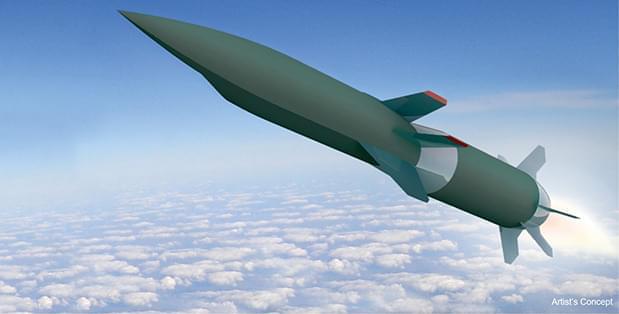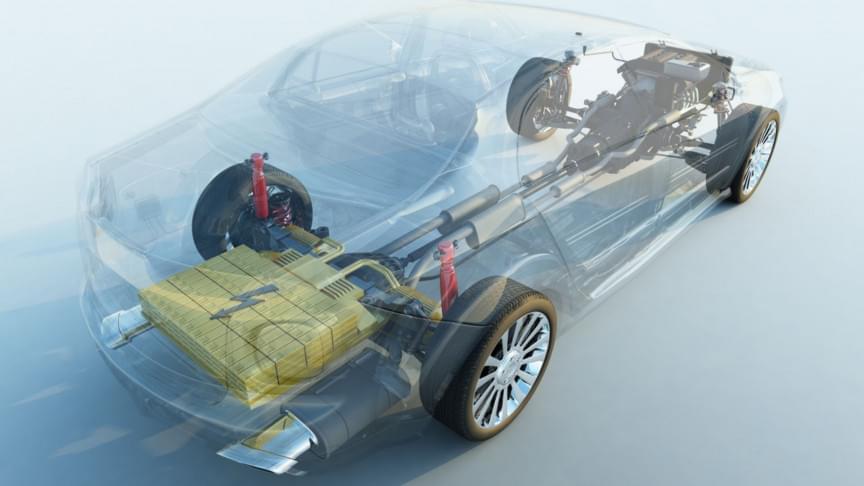NASA has tested the functions of Lucy, the agency’s first spacecraft to study Jupiter’s Trojan asteroids, filled it with fuel, and is preparing to pack it into a capsule for launch Saturday, October 16 2021. Named after characters in Greek mythology, these asteroids circle the Sun in two swarms, with one group leading ahead of Jupiter in its path, the other trailing behind it. Lucy will be the first spacecraft to visit these asteroids. By studying these asteroids up close, scientists hope to hone their theories on how our solar system’s planets formed 4.5 billion years ago and why they ended up in their current configuration.
Category: energy – Page 254

Hypersonic HAWC Missile Flies, but Details Are Kept Hidden
The Hypersonic Air-breathing Weapon Concept (HAWC) vehicle, developed under a partnership of the Air Force and the Defense Advanced Research Projects Agency, made a free flight the week of Sept. 20 a DARPA spokesman said, but most details are being withheld. The vehicle, which was built by Raytheon Technologies with a hypersonic engine built by Northrop Grumman, flew faster than Mach 5 but DARPA declined to say how long the vehicle flew.
The engine “kicked on” seconds after being released from an aircraft, which DARPA and the Air Force declined to identify, although DARPA expressed appreciation to “Navy flight test personnel.” The Navy has been conducting hypersonic missile research with F/A-18 aircraft.
The engine “compressed incoming air mixed with its hydrocarbon fuel and began igniting that fast-moving airflow mixture, propelling the cruiser at a speed greater than Mach 5,” DARPA said. In order for the scramjet engine to ignite, the vehicle must be moving at hypersonic speed, so a booster is used for that portion of the flight.
Space Powered Cooling May Be the Future of Energy
Our cooling systems are heating the Earth as they consume fossil-fueled energy and release greenhouse gases. Air Conditioning use is expected to increase from about 3.6 billion units to 15 billion by 2050. So, how do we exit this cold room trap? What if I told you we could tap into space for electricity free air conditioning and other refrigeration tech?
Purchase RoboRock on Amazon: https://cli.fm/Roborockdock_matt_YT_Amazon.
or Visit RoboRock’s Official Website: https://cli.fm/Roborockdock_matt_YT
Watch Perovskite Solar Cells Could Be the Future of Energy: https://youtu.be/YWU89g7sj7s?list=PLnTSM-ORSgi7sp17ey2ydGRGBTFijdYCh.
Video script and citations:
https://undecidedmf.com/episodes/space-powered-cooling-may-b…-of-energy.
Follow-up podcast:
Video version — https://www.youtube.com/channel/UC4-aWB84Bupf5hxGqrwYqLA
Audio version — http://bit.ly/stilltbdfm.
👋 Support Undecided on Patreon!

Lockheed Martin unveils LMXT aerial refueling tanker for the US Air Force
Some improvements of the new model include a significantly improved range, fuel offload capacity, operational and combat-proven advanced camera and vision system, and upgraded communications system. The tanker will have 271,700 pounds (123,241 kg) of fuel capacity – 12,000 kg more than the Airbus A330 MRTT and an almost 20-hour endurance.
“Lockheed Martin has a long and successful track record of producing aircraft for the US Air Force, and we understand the critical role tankers play in ensuring America’s total mission success,” said Greg Ulmer, executive vice president Lockheed Martin Aeronautics. “The LMXT combines proven performance and operator-specific capabilities to meet the Air Force’s refueling requirements in support of America’s National Defense Strategy.”
In addition to better range and increased payload, the LMXT tanker is equipped with a proven fly-by-wire boom currently certified and used by allies to refuel US Air Force receiver aircraft in operations around the world, the world’s first fully automatic boom/air-to-air refueling (A3R) system, and open system architecture JADC2 (Joint All-Domain Command and Control) systems.
Green Hydrogen’s Rapidly Falling Costs Undermine the Gas Industry’s Argument for Blue Hydrogen
A new study finds that hydrogen fuel produced from water using renewable energy will be cheaper than natural gas-based hydrogen with carbon capture by 2030.
New research predicts that green hydrogen — a clean fuel produced from water using renewables — will be comparable in cost and likely cheaper than blue hydrogen by 2030. This is much sooner than what the blue hydrogen industry is estimating when advocating for the natural gas-based fuel to be widely adopted — essentially eliminating the only viable argument to invest in blue hydrogen.
“The True Cost of Solar Hydrogen,” the report from a European research team led by the European Technology and Innovation Platform for Photovoltaics, was published September 7 in the journal Solar RRL and concludes that “during this decade, solar hydrogen will be globally a less expensive fuel compared with hydrogen produced from natural gas with CCS [blue hydrogen].” (CCS is carbon capture and storage.)
This is a much different scenario than the argument being made by supporters of blue hydrogen, such as the gas industry and others who are claiming that within a decade green hydrogen will still be at least double the cost of blue hydrogen.

Electrified road to wirelessly charge EVs in Michigan
Michigan will become the first state in America to deploy inductive vehicle charging technology in roads, in an effort to accelerate the adoption of electric vehicles (EVs).
Governor of Michigan, Gretchen Whitmer, made the announcement during the opening ceremony of the Motor Bella auto show on Tuesday. The Inductive Vehicle Charging Pilot is a partnership between Michigan’s Department of Transportation (MDOT) and the Office of Future Mobility and Electrification (OFME). It will deploy an electrified roadway system allowing electric cars, buses, shuttles and other vehicles to charge while driving, allowing them to operate continuously without stopping to charge. This will address range anxiety, while turning public roads into safe, sustainable, shared energy platforms.
“Michigan was home to the first mile of paved road, and now we’re paving the way for the roads of tomorrow with innovative infrastructure that will support the economy and the environment, helping us achieve our goal of carbon neutrality by 2050,” said Governor Whitmer. “This project reinforces my commitment to accelerating the deployment of electric vehicle infrastructure in Michigan and will create new opportunities for businesses and high-tech jobs amidst the transition to electric vehicles.”
New Solid-State Battery Surprises Researchers Who Created It
The study had been supported by LG Energy Solution’s open innovation, a program that actively supports battery-related research. LGES has been working with researchers around the world to foster related techniques.
Silicon anodes are famous for their energy density, which is 10 times greater than the graphite anodes most often used in today’s commercial lithium ion batteries. On the other hand, silicon anodes are infamous for how they expand and contract as the battery charges and discharges, and for how they degrade with liquid electrolytes. These challenges have kept all-silicon anodes out of commercial lithium ion batteries despite the tantalizing energy density. The new work published in Science provides a promising path forward for all-silicon-anodes, thanks to the right electrolyte.
“With this battery configuration, we are opening a new territory for solid-state batteries using alloy anodes such as silicon,” said Darren H. S. Tan, the lead author on the paper. He recently completed his chemical engineering PhD at the UC San Diego Jacobs School of Engineering and co-founded a startup UNIGRID Battery that has licensed this technology.
A New Battery-Free System Gives Devices an ‘Infinite Lifetime’
The newly developed battery-free system runs on harvested energy and can help massively reduce the growing e-waste problem.

New Research Could Usher in a New Age of Solid-State Batteries
LG Energy Solutions, a partner in the research, has plans for mass production of solid-state batteries by 2027.
While the transition to renewable energies is a high priority, there is also a need to develop energy storage equipment to tide over low production cycles. Lithium-ion batteries are currently our best bet but can’t serve very high energy requirements. Researchers at the University of California, San Diego, in collaboration with LG Energy Solutions, may have solved our requirement of energy-dense batteries by developing a solid-state battery with a silicon anode.
Lithium-ion batteries use graphite coated in copper foil, as their anodes or negative electrode. While this system does work well, future applications such as electric-powered flight and energy storage for grids require batteries with high energy densities. Scientists around the globe are working to resolve this issue and ubiquitous silicon is a potential answer.
Theoretically, silicon as an anode in a lithium-ion battery can deliver 10 times the energy capacity that graphite currently offers. Scientists have known this for decades and have tried to use silicon in batteries only to see them fare poorly. Silicon reacts with the liquid electrolytes in the batteries and even expands and contracts during charging and discharging cycles. This results in capacity losses over a period of time, taking away the edge that silicon offered in the first place.

Strange Electron Behavior Surprises Solid State Physicists
A surprise result for solid state physicists hints at an unusual electron behavior.
While studying the behavior of electrons in iron-based superconducting materials, researchers at the University of Tokyo observed a strange signal relating to the way electrons are arranged. The signal implies a new arrangement of electrons the researchers call a nematicity wave, and they hope to collaborate with theoretical physicists to better understand it. The nematicity wave could help researchers understand the way electrons interact with each other in superconductors.
A long-standing dream of solid state physicists is to fully understand the phenomenon of superconductivity — essentially electronic conduction without the resistance that creates heat and drains power. It would usher in a whole new world of incredibly efficient or powerful devices and is already being used on Japan’s experimental magnetic levitation bullet train. But there is much to explore in this complex topic, and it often surprises researchers with unexpected results and observations.